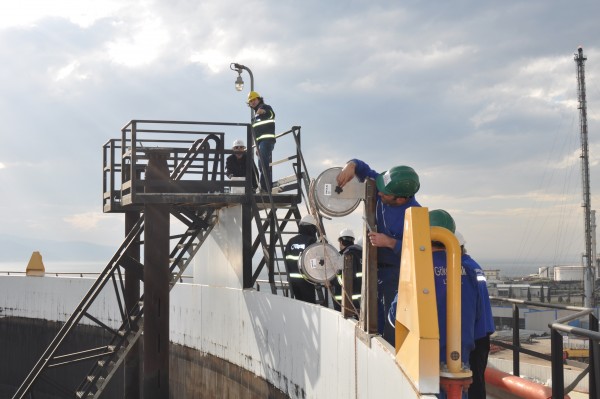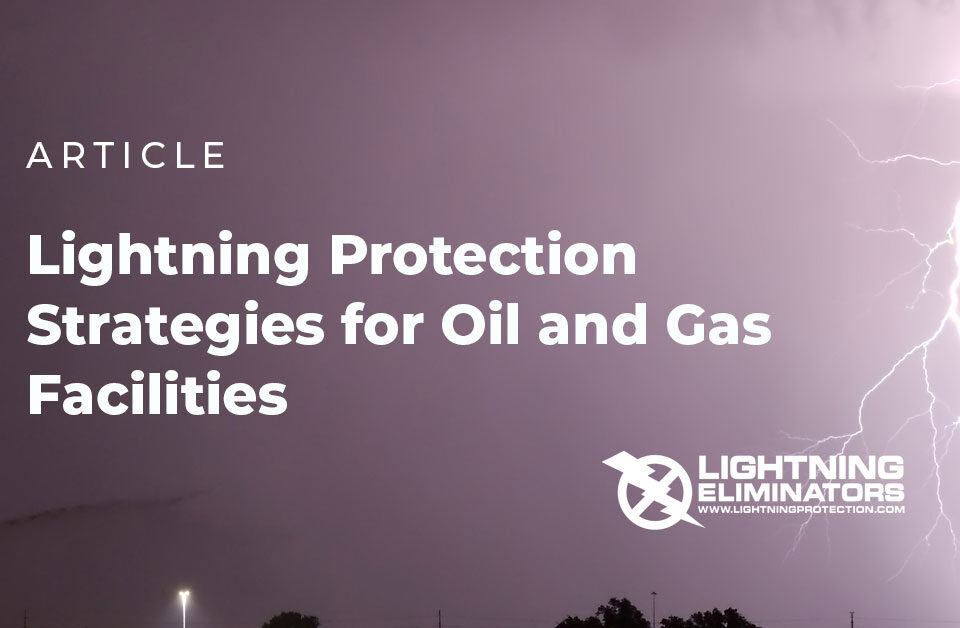- We Prevent Lightning Related Problems.

Lightning Prevention Win|Retraction Posted
April 24, 2014
Lightning Protection: Maintenance, Maintenance, Maintenance!
May 15, 2014The Original Lightning Protection for Floating Roof Tanks

Lightning Protection Blog
Week 84 | May 1, 2014
The Original, One and Only RGA: Beware of Copycats
Welcome to this week’s guest blogger, Peter Carpenter E.V.P of Applied Engineering, Lightning Eliminators
I asked Peter to write something on this subject because over the years we have seen so many copycats and knockoffs of a product which Lightning Eliminators conceived, designed and invented and also holds the U.S. patent on; the “Retractable Grounding Assembly”, also known as the “Grounding System for Floating Roofs in Flammable Storage Tanks” and better known as the “RGA”.
Several companies attempt to try to sell you their products, referencing our technology, as if they invented the technology, but “it just aint so!”
The development of the RGA started over 14 years ago and the design has evolved since it was submitted for patent in January 2001 US 7078621-B1. From the time it hit the market others have claimed to come out with similar product. They (you know, the infamous “they”) say that imitation is the highest form of flattery—in this case, it dangerous and damaging. The competitors simply do not have the time in the trenches, nor man-hours, installation hours or years of expertise invested into their solutions. They do not have the knowledge and/or experience that LEC has, nor will they ever, since they simply can never catch up to us. In addition, several of the copies are poorly made and do not perform as they should, which unfortunately ends up reflecting on us, because end-users confuse the copies with our product. Lightning Eliminator’s, RGA, as with all our products and solutions takes a hands-on custom approach and produces each item here in the United States with oversight and inspection, several in our own shop located in Boulder, CO.
It is important to note that some of our competition’s products have only been on the market for two or three years compared to LEC’s fourteen plus years in the field. In addition, the RGA meets API 545, and is CE and ATEX certified, whereas our competitors are not or do not say. As the designers, developers and creators of the RGA we know everything about how it works, why it works and we have tested it and are continuously working to make it better in line with customer requests and feedback. We have the track record whereby the competitors do not and cannot. We will always be ahead of the curve with the RGA.
Lightning Protection for Floating Roof Tanks
The RGA, By Peter Carpenter
For over twenty five years, there has been discussion and debate about the lightning risk of above-ground storage tanks. So much discussion and concern has been expressed throughout this industry that, a number of years ago, the American Petroleum Institute (API) actively re-evaluated their recommended procedures and practices for protecting against a direct or nearby lightning strike. About five years ago, API funded an independent third-party test, performed in cooperation with the API and the Energy Institute in England. These tests reflected that arcing will occur at the shunt/shell interface under all conditions; it does not matter if the shunts are clean or dirty, new or old, neglected or well maintained. Further, it also does not matter if the inner shell walls are clean, rusty, painted or coated, arcing will occur in all situations.
The consensus in the scientific community for lightning current induced on these tanks is that current discharge waveforms have three components. These are described as the A, B and C components. Without going into a lot of the finer details of the time base and current amplitude of these three different components, the major concern is the C component. The C component lasts much longer than the other two components (A & B) and thus contains the most energy which, over time, can ignite any flammable vapors that may be present above the seal where this spark would be generated.
A number of interesting points have been developed from this independent study. First, it now has been formally acknowledged that the existing standard or recommended practices provided by the industry still have inherent lightning risks. In addition, the new API-545 recommended practices have included three new recommendations/requirements to reduce the risk of a seal/tank fire caused by lightning activity. In short, these include installing submerged shunts between the roof and shell every 10 feet (3 meters) around the roof perimeter. Secondly, to electrically insulate all seal assembly components (including springs, scissor assemblies, seal membranes, etc.), and all gauge and guide poles from the tank roof. Lastly and, in LEC’s mind, the most important of these requirements, is to install bypass conductors between the roof and shell no more than every 30 meters (100 feet) around the tank circumference. A key point for this recommended practice is that the bypass conductors should be as short as possible.
LEC was already pointing out this lightning vulnerability to the industry years before this API 545 Recommended Practices acknowledged this problem. In fact, LEC’s Retractable Grounding Assembly (RGA) was introduced in late 1999 in order to address that unique lightning vulnerability for these floating roof tanks. Further, LEC received a U.S. patent (# US 7.078,621 B) on this product in 2006. LEC is the first company worldwide that not only brought this lightning vulnerability to the attention of the tank storage industry, but designed, tested and manufactures a product solution which is the RGA.
Since 1999 LEC has sold almost 6,000 units worldwide. These RGAs are located across a diverse spectrum of environments, weather variations and the products housed inside these tanks. Some of the weather variations include the extreme heat of Kuwait, high humidity of Malaysia, snow and ice of the upper Midwest of the United States and a combination of those environments in Oklahoma and Texas. The field performance results for the fourteen-plus year history of the RGA have been very positive. Numerous Fortune 500 companies have used these RGAs to protect their tank assets. Just a few of these companies include BP, Sunoco, Chevron, Shell, ExxonMobil, Valero, Kuwait Oil, Aramco and many others.

LEC’s Retractable Grounding Assembly-The Original RGA
LEC designed the RGA to have in excess of 25,000 full-cycle spring operations. That is well over 60 years of operation if the tank is cycled (emptied and filled) once a day during that time frame. The RGA housing is manufactured out of 316 stainless steel with the cable being a low resistance and inductance tinned copper. This ultra-low resistance and impedance cable ensures that the C component of the lightning discharge waveform is passed through the RGA and will not allow a spark across that air gap between the shunts and the tank shell. Also, this product only provides cable payout for the required cable length needed depending on the roof elevation. For example, if the tank roof is near the top of the tank, the effective cable resistance is at its lowest as the tinned cable retracts on itself and shorts that portion of unused cable. This provides full compliance with API 545. Other bonding conductors either provide a static cable length which for a 50-foot tall tank is 50-feet long or in other cases actually adds cable length to the lightning current carrying path and decreases the overall performance and thereby increases risk.

ATECO Copy of RGA
As a point of reference, LEC’s product development group and R & D department are always looking to improve product performance. These improvements cover the gambit of product improvement items from cost reduction considerations, installation improvements, product life cycle and ease of maintenance. As the RGA product progresses into its fifteenth historical year there will be, as with any product, additional enhancements incorporated into the next generation of the RGA to always keep LEC the industry leader in not only proactive lightning protection/prevention systems but also with the RGA grounding/bonding product.
For more information on this subject feel free to contact Peter Carpenter at PeterC@lecglobal.com
As always if you have any questions or need additional information please feel free to contact me at LightningDiva@lecglobal.com
Be careful out there! Visit www.lightningprotection.com for all your lightning protection needs. Follow us on Twitter, Facebook and LinkedIn for more information and updates as well as some great photos.

